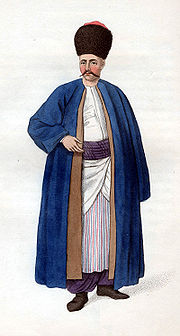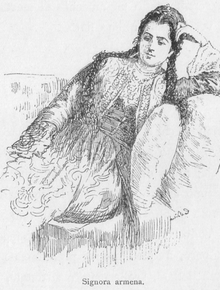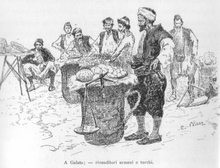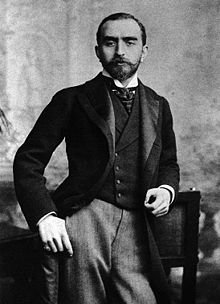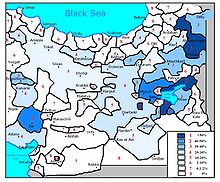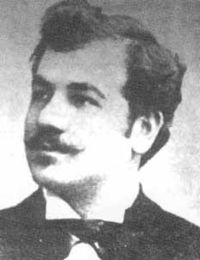- Armenians in the Ottoman Empire
-
Main article: History of Armenia
Social structure of the
Ottoman Empire
History of Armenia 
This article is part of a seriesPrehistory
2400 BC - 590 BCName of Armenia Hayk Hayasa-Azzi Nairi · Urartu Antiquity
591 BC - 428 ADOrontid Armenia Kingdom of Armenia Kingdom of Sophene Kingdom of Commagene Lesser Armenia Roman Armenia Dynasties: Orontid · Artaxiad · Arsacid Middle Ages
429 - 1375Marzpanate Period Byzantine Armenia Sassanid Armenia Arab conquest of Armenia Emirate of Armenia Bagratid Armenia Kingdom of Vaspurakan Armenian Kingdom of Cilicia Zakarid Armenia Dynasties: Bagratid · Rubenid · Artsruni Foreign Rule
1376 - 1918Persian · Ottoman · Russian Armenian Oblast Armenian national movement Hamidian massacres Armenian Genocide Contemporary
1918 - presentDemocratic Republic of Armenia Armenian Soviet Socialist Republic Nagorno-Karabakh War Republic of Armenia
Armenia Portal
Armenians in the Ottoman Empire or Ottoman Armenians were ethnic Armenian people of the Armenian Apostolic Church, the Armenian Catholic Church or the Armenian Protestant Church (which was formed in the 19th century) who lived in the Ottoman Empire. Ottoman Armenians belonged to the Armenian Millet until the 19th century.
Contents
Background
See also: State organisation of the Ottoman EmpireThe Ottomans developed a number of unique traits into the traditional Islamic civilization, which did not have a separation between religious and secular matters. Ottomans visualized an idea that two separate "establishments" shared state power. Historians often label the Ottoman sociopolitical construct the "Ottoman System," which characterized by slave government administration (military governing) and state power (civil governing) sharing between governing and religious "establishments." The Ottomans left the civic control to the civic institutions. That term, however, conveys a sense of structural rigidity that probably was nonexistent throughout the Ottoman period as Sultan is the highest power over everything, since with the state organization operating specific model in the first half of the sixteenth century under Suleyman I, also known as "Lawgiver", gained more definite organization.
The Armenian population's integration was partly due to the nonexistent structural rigidity throughout the initial period. Armenian people, related to the issues of their own internal affairs were, were administered by the civil administration. Townspeople, villagers and farmers formed a class called the reaya, including Armenian reaya. Civil and judicial administration was carried out under a separate parallel system of small municipal or rural units called kazas. The civil system was considered a check on the military system since beys, who represented executive authority on reaya, could not carry out punishment without a sentence from the religious leader of the person. As a dip note; Sultan was beyond the mentioned control. Ecumenical Patriarchate was the leader of the Armenian People. This whole structure named as Millet, or in Armenian case Armenian Millet
During the Byzantine period, the Armenian Church was not allowed to operate in Constantinople, because the Greek Orthodox Church regarded the Armenian Church as heretical. With the establishment of Ecumenical Patriarchate of Constantinople, Armenians become religious leaders, and bureaucrats under Ottoman Empire, more influential than just their own community. The idea that two separate "establishments" shared state power gave people a chance to occupy important positions, administrative, the religious-legal, and the social-economic.
Patriarchate of Constantinople
See also: Armenian Patriarch of Constantinople and Armenian Millet Costumes of the Ottoman Empire extending to Muslims, Christians, Jewish communities, clergy, tradesmen, state and military officials were strictly regulated during the reign of Süleyman the Magnificent.
Costumes of the Ottoman Empire extending to Muslims, Christians, Jewish communities, clergy, tradesmen, state and military officials were strictly regulated during the reign of Süleyman the Magnificent.
After Constantinople fell to the Ottoman Turks in 1453, the patriarchate came to care more directly for all the Orthodox living in the Ottoman Empire. Hovagim I was at the time the Metropolitan of Bursa. In 1461, Hovagim I was brought to Constantinople by Sultan Mehmed II and established as the Armenian Patriarch of Constantinople which the office was created solely with a political purpose. Sultan Mehmed II wanted Armenian-Greek separation. Constantinople become the real center of their ecclesiastical and national life. The Armenian patriarch and not the Catholicos of Etschmiadzin, was their most important national dignitary, as part of Mehmed's wish. In the Sultan's capital, lived the largest Armenian community in the world; and his civil-ecclesiastical authority made the Sultan practically the most powerful official among the Armenians at large.
Until the promulgation of the Hatt-i Sherif of 1839, the patriarch and his clients, within limits, possessed penal authority over Armenian people. At the capital the patriarch had his own jail, and maintained a small police force. His authority over his clergy being absolute, he could imprison or exile them at will; and while he was compelled to secure the consent of the Sultan to imprison or exile laymen of his community, the necessary firman was very easily obtained. The patriarchal system of government, in placing civil powers in the hands of high ecclesiastics, was an outcome of the fact that the Sultan made no distinction between church and community, and often lent the weight of its authority to maintain the integrity of the church.
The spiritual condition of the Armenian church until "national awakening" was based on superstition, ceremonialism, and priestcraft. The veneration of anointed crosses, of pictures and relics of saints, the giving of alms, the observance of penances, fasts, and vigils, and the going on pilgrimages to Etschmiadzin and Jerusalem, to most Armenians constituted the sum and substance of religion. Preaching in the Armenian church was very uncommon. The parish priests never preached. Most of the preaching was done by vartabeds sent out from Etschmiadzin, Jerusalem, and other monastic centers, with whom it was partly a matter of reciting the virtues of relics and recounting the legends of saints, and largely a matter of appealing for contributions. The Bible was not generally read. The copies of Bible were not easily accessible.
Armenian village life
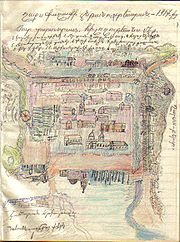 A hand drawn illustration of Kars in 1917 by an Armenian. The citadel can be seen on the right. Note the two large domed Armenian Church[disambiguation needed
A hand drawn illustration of Kars in 1917 by an Armenian. The citadel can be seen on the right. Note the two large domed Armenian Church[disambiguation needed
 ]es in the middle and lower section of the picture.
]es in the middle and lower section of the picture.At the villages, even for the ones that the population was chiefly Muslim, the Armenian quarters were settled in groups among other parts of the population. Comparatively Armenians lived in well-built and prosperous places. The houses are arranged one above the other, so that the flat roof of one house is the front yard of the one above. For safety the houses are huddled together. Armenian houses were admirably adapted to the extremes of temperature of Western Armenian Highlands (Eastern Anatolia). In summer the thick walls and earth-cowered roofs keep the rooms cool. The nature and agricultural traditions of Armenians stayed the same as same characteristics explained can also be found in Xenophon who described many aspects of Armenian village life and hospitality.[1] He relates that the people spoke a language that to his ear sounded like the language of the Persians.[2]
There is always a village master (Bey or elderly); for entertaining the town house was part of his prerogative, and his house is the best in each village. It is not uncommon to have three priests for here thirty-five families. Most of the Armenians like to travel on horseback to a neighboring villages, sometimes for religious ceremonies (like Van festival), sometimes to fetch a bride, accompanying her, with musical instruments and clapping of hands, to their own village.
Ottoman Armenia 1453 to 1829
Armenians preserved their culture, history, and language through the course of time, largely thanks to their distinct religious identity among the neighboring Turks and Kurds. Like the Greek Orthodox and Jewish minorities of the Ottoman Empire, they constituted a distinct millet, led by the Armenian Patriarch of Constantinople. Under this system, Christians and Jews were considered religious minorities/second-class citizens; they were subjected to elevated taxation, but in return they were granted autonomy within their own religious communities and were exempted from military service. Growing religious and political influence from neighboring communities necessitated implementation of security measures that often required a longer waiting period for minorities to seek legal recourse in the courts.[3] Under the Ottoman rule, Armenians formed three distinct millets: Armenian Orthodox Gregorians, Armenian Catholics, and Armenian Protestants (which was formed in the 19th century).[4]
After many centuries of Turkish rule in Anatolia (at first the Seljuks, then the rule of a variety of Anatolian beyliks and finally the Ottomans), the centres with a high concentration of Armenians lost their geographic continuity (parts of Van, Bitlis, and Kharput vilayets). Over the centuries, tribes of Turks and Kurds settled into Anatolia and the historic Armenian land, which was left severely depopulated by the a slew of devastating events such as the Byzantine-Persian Wars, Byzantine-Arab Wars, Turkish Invasions, Mongol Invasions and finally the bloody campaigns of Tamerlane.[5] Owing to these events the composition of the population had undergone, ever since the second half of the medieval period, a transformation so profound that the Armenians constituted, over the whole extent of their ancient homeland, no more than a quarter of the total inhabitants.[6][7][8] Despite this they kept and defended factual autonomy in certain isolated areas like Sassoun, Shatakh, and parts of Dersim[citation needed]. An Armenian stronghold and a symbol of factual Armenian autonomy, Zeitoun (Ulnia) was located between the Six Vilayets and Cilicia, which also had a strong Armenian presence ever since the creation of the Principality (and then Kingdom) of Lesser Armenia. However, the destruction of the Kingdom by Ramadanid tribe and the subsequent rule of Muslim powers such as the Dulkadirids, the Mamluks and the Ottomans led to an ever increasing numbers of Muslims in the region until finally the genocide removed the remaining vestiges of Armenians.
There were also significant communities in parts of Trebizond and Ankara vilayets bordering Six vilayets (like in Kayseri). After the Ottoman conquests many Armenians also settled in Western Anatolia, in large and prosperous Ottoman cities like Istanbul and Izmir.
Western Armenia, 1829–1918
See also: Russian ArmeniaThe remaining Ottoman Armenia, composed of the Six vilayets (Erzurum, Van, Bitlis, Diyarbekir, Kharput, and Sivas[9]) till World War I, under Ottoman rule, was also referred to as Western Armenia.
Armenians during 19th Century
Besides the learned professions with the schools opened throughout the Ottoman Empire, the chief occupations were trade and commerce, various industries, and agriculture. The peasants, for the most part, were agriculturists. In the empire Armenians were raised to higher occupations, like Calouste Sarkis Gulbenkian was a businessman and philanthropist. He played a major role in making the petroleum reserves of the Middle East available to Western development. The Armenian Press and literature during this period established institutions that were critical; this attitude has been invaluable in reforming abuses and introducing improvements of Armenian people in their communities. Thus their critical instinct is positive, rather than negative. Armenians organised themselves for different objects; witness their numerous societies, clubs, political parties, and other associations. Hovsep Pushman was a painter who become very famous in the Empire. During this period Armenians would establish a church, a school, a library, and a newspaper. Sargis Mubayeajian was a prolific and multifarious Armenian writer educated in Constantinople. Many of his works are still scattered in Armenian periodicals.
Many Armenians, who have emigrated to foreign countries become prosperous there, return to their native land because the love of the Mother Country is so intense in them. Alex Manoogian who become a philanthropist and active member of Armenian General Benevolent Union was from Ottoman lands (modern Izmir), Arthur Edmund Carewe born Trebizond become an Actor in the silent film era.
See also: Balyan family, Vartan Pasha, Güllü Agop, Hampartsoum Limondjian, and Kemani Tatyos EkserciyanEastern Question
See also: Rise of nationalism under the Ottoman Empire and Eastern QuestionThe Eastern Question (normally dated to 1774), in European history used in referring the diplomatic and political problems posed by the decay of the Ottoman Empire, during the 18th century, including instability in the territories ruled by the Ottoman Empire. The position of educated and privileged Christians within the Ottoman Empire improved in the 17th and 18th centuries. Empire increasingly recognized the missing skills which the larger Ottoman population lacked, as the empire became more settled, and began to feel its increasing backwardness in relation to the European powers, European powers on the other side, engaged in a power struggle to safeguard their military, strategic and commercial interests in the Empire, this gave the motivation to the powers to help people in need. The rise of nationalism under the Ottoman Empire, direct result of enlightenment of Christian millets through education, was the dominant theme, though Armenians, for the most part, remained passive during these years, earning them the title of millet-i sadıka or the "loyal millet."[10]
The Eastern Question gained another dimension by the late 1820s, Greek Enlightenment and Greek War of Independence already developed the conditions to establish the Greece, along with several countries of the Balkans, frustrated with conditions, had, often with the help of the Powers, broken free of Ottoman rule. The Great Power Imperial Russia stood to benefit from the decline of the Ottoman Empire; on the other hand, Austria and the United Kingdom deemed the preservation of Empire to be in their best interests. The position of France changed several times over the centuries. Armenian involvement into international view would had to wait until Armenian national awakening, which the Armenian Question as used in European history, became common place among diplomatic circles and in the popular press after the Congress of Berlin (1878). The Armenian national ideology developed long after the Greek movement, however the factors contributing to the emergence of Armenian nationalism made the movement far more similar to that of the Greeks than those of other ethnic groups.[11]
Reform implementation, 1860s–1880s
See also: Tanzimat and Armenian QuestionThe three major European powers, Great Britain, France and Russia (known as the Great Powers), took issue with the Empire's treatment of its Christian minorities and increasingly pressured the Ottoman government (also known as the Sublime Porte) to extend equal rights to all its citizens.
Beginning in 1839, the Ottoman government implemented the Tanzimat reforms to improve the situation of minorities, although these would prove largely ineffective. In 1856, the Hatt-ı Hümayun promised equality for all Ottoman citizens irrespective of their ethnicity and confession, widening the scope of the 1839 Hatt-ı Şerif of Gülhane. The reformist period peaked with the Constitution, called the Kanûn-ı Esâsî (meaning "Basic Law" in Ottoman Turkish), written by members of the Young Ottomans, which was promulgated on 23 November 1876. It established freedom of belief and equality of all citizens before the law. "Firman of the Reforms" gave immense privileges to the Armenians, which formed a "governance in governance" to eliminate the aristocratic dominance of the Armenian nobles by development of the political strata in the society.[12]
Armenian National Constitution, 1863
See also: National Assembly of ArmeniaIn 1863 the Armenian National Constitution (Ottoman Turkish:"Nizâmnâme-i Millet-i Ermeniyân") was Ottoman Empire approved. It was a form of the "Code of Regulations" composed of 150 articles drafted by the "Armenian intelligentsia", which defined the powers of Patriarch (position in Ottoman Millet) and newly formed "Armenian National Assembly".[13] Mikrtich, issued a decree, permitting women to have equal votes with men and asking them to take part in all elections.
Armenian National Assembly had wide ranging functions. That Muslim officials (Turks, Kurds, Arabs) did not used to employed to collect taxes in Armenian villages, but the taxes in all the Armenian villages collected by Armenian tax-gatherers appointed by the Armenian National Assembly. Armenians allowed to establish their own courts of justice for the purpose of administering justice and conducting litigation between Armenian and Armenian, and for deciding all questions relating to marriage, divorce, estate, inheritance, etc., appertaining to themselves. Also Armenians allowed the right to establish their own prisons for the incarceration of offending Armenians, and in no case should an Armenian be imprisoned in a Ottoman prison.
The Armenian National Assembly also had the power to elect the Armenian Governor by an local Armenian legislative council. The councils later will be part of elections during second constitutional era. Local Armenian legislative councils were composed of six Armenians elected by the Armenian National Assembly.
Education and social work
Main article: Armenian education in the Ottoman EmpireBeginning in 1863, education has been offered to the whole people, and so far as funds permit is absolutely free for all. All Armenian education is under the direction of lay committees. During this period in Russian Armenia the association of the schools with the Church is rather closer, but the same principle obtains. This became a problem for Russian administration, which was peaked during 1897, Tsar Nicholas appointed the Armenophobic Grigory Sergeyevich Golitsin as governor of Transcaucasia, and Armenian schools, cultural associations, newspapers and libraries were closed.
The Armenian charitable works, hospitals, and provident institutions we were organized along the explained perspective. The Armenians, in addition to paying taxes to the State, have voluntarily imposed extra burdens on themselves in order to support such philanthropic agencies. The taxes to the State did not have direct return to Armenians in such cases.
The education and philanthropic agencies made the Armenians most educated and rich section of the Ottoman population.
Armenian Question, 1877
The Armenian Question as used in European history, became common place among diplomatic circles and in the popular press after the Congress of Berlin (1878); that in like Eastern Question (normally dated to 1774), refers to powers of Europe's involvement to the Armenian subjects of the Ottoman Empire beginning with the Russo-Turkish War of 1877-78. However in specific terms, the Armenian question refers to the protection and the freedoms of Armenians from their neighboring communities.[14] The "Armenian question" explains the forty years of Armenian-Ottoman history in the context of English, German, Russian politics between 1877-1914.
National awakening, 1880s
See also: Armenian national awakeningThe national liberation movement of the Balkan peoples (see: national awakenings in Balkans) and the immediate involvement of the European powers in the Eastern question had a powerful effect on the hitherto suppressed national movement among the Armenians of the Ottoman Empire - on the development of a national liberation ideology.[15] The Armenian national liberation movement was the Armenian national effort to free the historic Armenian homeland of eastern Asia Minor and Transcaucasus from Russian and Ottoman domination and re-establish the independent Armenian state. Those Armenians who did not support national liberation aspirations or who were neutral were called chezoks.
Sultan Abdul Hamid, 1876 - 1909
Abdülhamid II was the 34th sultan and he oversaw a period of decline in the power and extent of the Empire, ruling from August 31, 1876 until he was deposed on April 27, 1909. Abdülhamid II was the last Ottoman Sultan to rule with absolute power.
Bashkaleh Resistance, 1889
The Bashkaleh Resistance was the bloody encounter between the Armenakans and the Ottoman Empire on May 1889. It is named as Bashkaleh Resistance as Bashkaleh was a border town of Van Province, Ottoman Empire. The event was important as it was reflected on main Armenian newspapers as the recovered documents on the Armenakans showed an extensive plot for an national movement.[16] Ottoman officials believed that the men were members of a large revolutionary apparatus and the discussion was reflected on newspapers, (Eastern Express, Oriental Advertiser, Saadet, and Tarik) and the responses were on the Armenian papers. In some Armenian circles, this event was considered as a martyrdom and brought other armed conflicts.[17] The Bashkaleh Resistance was on the Persian border, which the Armenakans were in communication with Armenians in the Persian Empire. The Gugunian Expedition, which followed within the couple months, was an attempt by a small group of Armenian nationalists from the Russian Armenia to launch an armed expedition across the border into the Ottoman Empire in 1890 in support of local Armenians.
Kum Kapu demonstration, 1890
The Kum Kapu demonstration occurred at the Armenian quarter of Kum Kapu, the seat of the Armenian Patriarch, was spared through the prompt action of the commandant, Hassan Aga.[18] On 27 July 1890, Harutiun Djangulian, Mihran Damadian and Hambartsum Boyajian interrupted the Armenian mass to read a manifesto and denounce the indifference of the Armenian patriarch and Armenian National Assembly. Harutiun Djangulian (member from Van) tried to assassinate the Patriarch of Istanbul. The goal was to persuade the Armenian clerics to bring their policies into alignment with the national politics. They soon forced the patriarch to join the procession heading to the Yildiz Palace to demand implementation of Article 61 of the Treaty of Berlin. It is significant that this massacre, in which 6000 Armenians are said to have perished, was not the result of a general rising of the Muslim population.[18] The Softas took no part in it, and many Armenians found refuge in the Muslim sections of the city.[18]
Bloody Years, 1894–1896
See also: Hamidian Massacres, Sasun Resistance (1894), Zeitun Rebellion (1895–1896), 1896 Ottoman Bank Takeover, Defense of Van, and Khanasor ExpeditionThe first notable battle in the Armenian resistance movement took place in Sassoun, where nationalist ideals were proliferated by Hunchak activists, such as Mihran Damadian, Hampartsoum Boyadjian, and Hrayr. The Armenian Revolutionary Federation also played a significant role in arming the people of the region. The Armenians of Sassoun confronted the Ottoman army and Kurdish irregulars at Sassoun, succumbing to superior numbers.[19] This was followed by Zeitun Rebellion (1895–1896), which between the years 1891 and 1895, Hunchak activists toured various regions of Cilicia and Zeitun to encourage resistance, and established new branches of the Social Democrat Hunchakian Party.
In 1896 Ottoman Bank Takeover took place, by an Armenian group armed with pistols, grenades, dynamite and hand-held bombs. The seizure of the bank lasted for fourteen hours, resulting in the deaths of ten of the Armenian men and Turkish soldiers. Turkish reaction to takeover saw further massacres and pogroms of the several thousand Armenians living in Constantinople and also Hamid threatening to level the entire building itself. However, intervention on part of the European diplomats in the city managed to persuade the men to give, assigning safe passage to the survivors to France. Despite the level of violence the incident had wrought, the takeover was reported positively in the European press, praising the men for their courage and the objectives they attempted to accomplish.[20] The years between 1894-1896 ended, with estimates of the dead ranging from 80,000 to 300,000.[21] The massacres are named for Abdul Hamid II, whose efforts to reinforce the territorial integrity of the embattled Ottoman Empire.
Sasun Uprising, 1904
Ottoman Officials responsible from Sasun Uprising, who were previously defeated in the First Zeitoun Resistance, didn't want the formation of another semi-autonomous Armenian region in the "Eastern" vilayets. In Sassoun, Armenian activists were working to arm the folk and to recruit young men by motivating them to the Armenian cause. 50,000 Turkish and Kurdish troops started the offensive in Sassoun, where 500 fedayees had to defend 20,000 unarmed people. The Armenians were headed by Andranik Ozanian along with Kevork Chavoush, Sepasdatsi Mourad, Keri, Hrayr Tjokhk, and others.[22]
Yıldız Attempt, 1905
See also: Yıldız AttemptThe events of the Hamidian massacres and Sultan Abdul Hamid II's continued anti-Armenian policies[23] gave way for the Armenian Revolutionary Federation to plan an assassination attempt on the sultan to enact vengeance. Dashnak members, led by ARF founder Christapor Mikaelian, secretly started producing explosives and planning the operation in Sofia, Bulgaria.
Dissolution, 1908–1918
See also: Dissolution of the Ottoman Empire Declaration of the Constitution Muslim, Armenian, Greek leaders together
Declaration of the Constitution Muslim, Armenian, Greek leaders together
The Second Constitutional Era of the Empire began shortly after Sultan Abdülhamid II restored the constitutional monarchy after the 1908 Young Turk Revolution. The period established many political groups. A series of elections during this period resulted in the gradual ascendance of the Committee of Union and Progress's ("CUP") domination in politics. This period also marked the dissolution of the Ottoman Empire.
Young Turk revolution, 1908
Karekin Pastermadjian member of "Chamber of Deputies" representative of the Armenian Revolutionary Federation from Erzurum. He was later elected to be ambassador of the Armenia to the United States.
On July 24, 1908, Armenians' hopes for equality in the empire brightened with the removal of Hamid II from power and restored the country back to a constitutional monarchy. Two of the largest revolutionary groups trying to overthrow Sultan Abdul Hamid II had been the Armenian Revolutionary Federation and the Committee of Union and Progress, a group of mostly European-educated Turks.[24] In a general assembly meeting in 1907, the ARF acknowledged that the Armenian and Turkish revolutionaries had the same goals. Although the Tanzimat reforms had given Armenians more rights and seats in the parliament, the ARF hoped to gain autonomy to govern Armenian populated areas of the Ottoman Empire as a "state within a state". The "Second congress of the Ottoman opposition" took place in Paris, France, in 1907. Opposition leaders including Ahmed Riza (liberal), Sabahheddin Bey, and ARF member Khachatur Maloumian attended. During the meeting, an alliance between the two parties was officially declared.[24][25] The ARF decided to cooperate with the Committee of Union and Progress, hoping that if the Young Turks came to power, autonomy would be granted to the Armenians.
Armenian reform package, 1914
 The Armenian reform package declared that the vilayets which Armenians living were to be under an inspectors general, (the map is an archive document of 1914 Census).[26]
The Armenian reform package declared that the vilayets which Armenians living were to be under an inspectors general, (the map is an archive document of 1914 Census).[26]
The Armenian reform package was an arrangement negotiated with Russia, acting on behalf of the Great Powers, and the Ottoman Empire. It aimed to introduce reforms to the Armenian citizens of the empire. This agreement, which was solidified in February 1914 was based on the arrangements nominally made in 1878. According to this arrangement the inspectors general, whose powers and duties constituted the key to the question, were to be named for a period of ten years, and their engagement was not to be revocable during that period.
World War I, 1914-1918
Main article: Armenian GenocideWith onslaught of World War I, the Ottoman Empire and Russian Empire engaged during the Caucasus and Persian Campaigns, the CUP began to look on the Armenians with distrust and suspicion. This was due to the fact that the Russian army contained a contingent of Armenian volunteers. On April 24, 1915, Armenian intellectuals were arrested by Ottoman authorities and, with the Tehcir Law (29 May 1915), eventually a large proportion of Armenians living in Anatolia perished in what has become known as the Armenian Genocide. There was local Armenian resistance in the region, developed against the activities of the Ottoman Empire. The events of 1915 to 1917 are regarded by Armenians and the vast majority of Western historians and even some Turkish writers and historians like e.g. Taner Akçam and Orhan Pamuk to have been state-sponsored and planned mass killings, or genocide.
See also
- History of Armenia
- Timeline of Armenian history
- Armenians in Turkey
- Ottoman Armenian population
- Armenian Patriarch of Constantinople
- Armenian Sport in the Ottoman Empire
References
- ^ Minasyan, Smbat (2008-06-21). "Armenia as Xenophon saw it". http://armenian-history.com/Nyuter/HISTORY/ArmeniaBC/armenia_as_xenophon_saw_it.htm. Retrieved 2008-09-03.
- ^ Anabasis (Xenophon), IV.v.2-9.[verification needed]
- ^ We and They: Armenians in the Ottoman Empire
- ^ Ortaylı, İlber. Son İmparatorluk Osmanlı (The Last Empire: Ottoman Empire), İstanbul, Timaş Yayınları (Timaş Press), 2006. pp. 87-89. ISBN 975-263-490-7 (the book is in Turkish)
- ^ Wolf-Dieter Hütteroth and Volker Höhfeld. Türkei, Darmstadt 2002. pp. 128-132.
- ^ M. Canard: "Armīniya" in Encyclopaedia of Islam, Leiden 1993.
- ^ G. L. Selenoy and N. von Seidlitz: "Die Verbreitung der Armenier in der asiatischen Türkei und in Trans-Kaukassien", in: Petermanns Mitteilungen, Gotha 1896.
- ^ McCarthy, Justin: The Ottoman Peoples and the end of Empire; London, 1981; p.86
- ^ Cahoon, Ben (2000), "Armenia", World Statesmen, http://www.worldstatesmen.org/Armenia.html.
- ^ Dadrian, Vahakn N. The History of the Armenian Genocide: Ethnic Conflict from the Balkans to Anatolia to the Caucasus. Oxford: Berghahn Books, 1995, p. 192. ISBN 1-5718-1666-6
- ^ Hovannisian, Richard, The Armenian Genocide: History, Politics, Ethics, pg.129
- ^ Ortayli, Ilber, Tanzimattan Cumhuriyete Yerel Yönetim Gelenegi, Istanbul 1985, pp. 73
- ^ Hovannisian, Richard "The Armenian People from Ancient to Modern Times" pg.198
- ^ Armenian Studies: Études Arméniennes by Lebanese Association of Armenian University Graduates, pp. 4-6
- ^ Kirakossian, Arman J. British Diplomacy and the Armenian Question: From the 1830s to 1914, page 58
- ^ Ter-Minasian, Ruben. Hai Heghapokhakani Me Hishataknere [Memoirs of an Armenian Revolutionary] (Los Angeles, 1952), II, 268-269.
- ^ Darbinian, op. cit., p. 123; Adjemian, op. cit., p. 7; Varandian, Dashnaktsuthian Patmuthiun, I, 30; Great Britain, Turkey No. 1 (1889), op. cit., Inclosure in no. 95. Extract from the "Eastern Express" of June 25, 1889, pp. 83-84; ibid., no. 102. Sir W. White to the Marquis of Salisbury-(Received July 15), p. 89; Great Britain, Turkey No. 1 (1890), op. cit., no. 4. Sir W. White to the Marquis of Salisbury-(Received August 9), p. 4; ibid., Inclosure 1 in no. 4, Colonel Chermside to Sir W. White, p. 4; ibid., Inclosure 2 in no. 4. Vice-Consul Devey to Colonel Chermside, pp. 4-7; ibid., Inclosure 3 in no. 4. M. Patiguian to M. Koulaksizian, pp. 7-9; ibid., Inclosure 4 in no.
- ^ a b c Creasy, Edward Shepherd. Turkey, pg.500.
- ^ Kurdoghlian, Mihran (1996) (in Armenian). Hayots Badmoutioun, Volume III. Athens, Greece: Hradaragoutioun Azkayin Ousoumnagan Khorhourti. pp. 42–44.
- ^ Balakian, Peter. The Burning Tigris: The Armenian Genocide and America's Response. New York: Perennial, 2003. pp. 107-108
- ^ Akcam, Taner. A Shameful Act. 2006, pg.42.
- ^ Kurdoghlian, Mihran (1996) (in Armenian). Hayots Badmoutioun, Volume III. Athens, Greece: Hradaragoutioun Azkayin Ousoumnagan Khorhourti. pp. 47.
- ^ Kirakosian, Arman Dzhonovich. The Armenian Massacres, 1894-1896: 1894-1896 : U.S. media testimony, Page 33.
- ^ a b Kansu, Aykut (1997). The Revolution of 1908 in Turkey. Brill Academic Publishers. pp. 78. ISBN 9004102833.
- ^ Kurdoghlian, Mihran (1996) (in Armenian). Hayots Badmoutioun (Armenian History). Athens, Greece: Hradaragutiun Azkayin Oosoomnagan Khorhoortee. pp. 52–53.
- ^ Kirakosian, J. S., ed. Hayastane michazkayin divanakitut'yan ew sovetakan artakin kaghakakanut'yan pastateghterum, 1828-1923 (Armenia in the documents of international diplomacy and Soviet foreign policy, 1828-1923). Erevan, 1972. p.149-358
 Armenia topics
Armenia topicsHistory (timeline) EarlyOrigins · Name · Kura-Araxes culture · Hayk · Hayasa-Azzi · Mitanni · Nairi · Kingdom of Urartu · Orontid dynasty · Kingdom of Armenia · Roman Armenia · Byzantine Armenia · Bagratuni Armenia · Armenian Kingdom of CiliciaMiddleModernBy topicGovernment and
politicsConstitution · President · Prime Minister · National Assembly · Political parties · Elections · Foreign relations · Corruption · Human rights · LGBT rights · Relations with the European Union · more on government / politicsEconomy Armenian dram · Central Bank · List of companies · Armex · Agriculture · Industry · Communications · Transport · Energy · Mining · Waste management · International rankingsAdministrative
divisionsArmed Forces Geography Demographics Religion Culture Symbols History of modern states under the Ottoman Empire Africa Asia Europe Albania · Bosnia and Herzegovina · Bulgaria · Greece · Hungary · Kosovo · Macedonia · Montenegro · SerbiaCategories:- Ottoman Armenians
- People of the Ottoman Empire
Wikimedia Foundation. 2010.

